Ever have one of those mornings where your bike kicks over, but it just won’t start?
Me? I just want to get a set of the shades and the hat that dude was wearing.
Motorcycles, Scooters, Guns, Adventures, Opinions, and More
Ever have one of those mornings where your bike kicks over, but it just won’t start?
Me? I just want to get a set of the shades and the hat that dude was wearing.
Here’s another stunning motorcycle in the Motor Museum of Western Australia. It’s kind of wild that I am finding this exotic American iron on the other side of the planet (see our earlier blog on the 1920 Excelsior-Henderson), but hey, beauty knows no bounds!
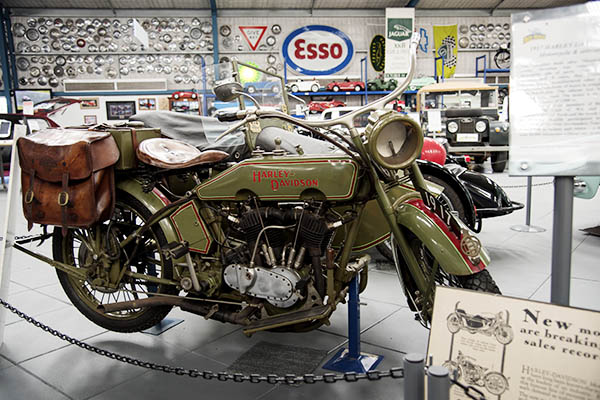
The bike is beautiful, and the colors just flat work for me. I guess they worked for Harley-Davidson, too…in the mid-1980s they offered a Heritage model Shovelhead with the identical “pea green” color theme. I wish I had purchased one of those back in the day. Lord only knows what they are going for now.
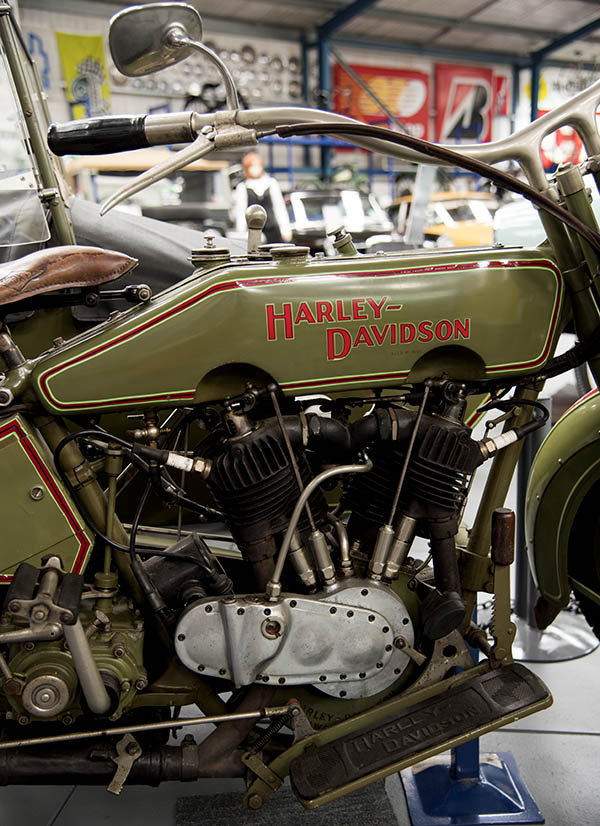
Check out the exposed pushrods, rocker arms, valve stems, and fuel tank cutouts in the photo above. And then take a look at the leather work on the saddlebags below…
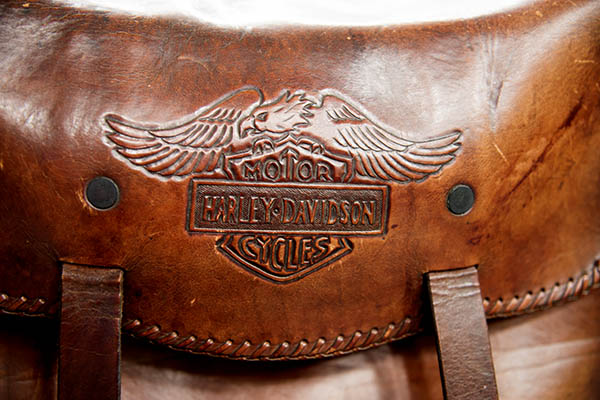
I’ll let the Motor Museum’s words do the talking here, folks…check out the distances covered on this bike, too!
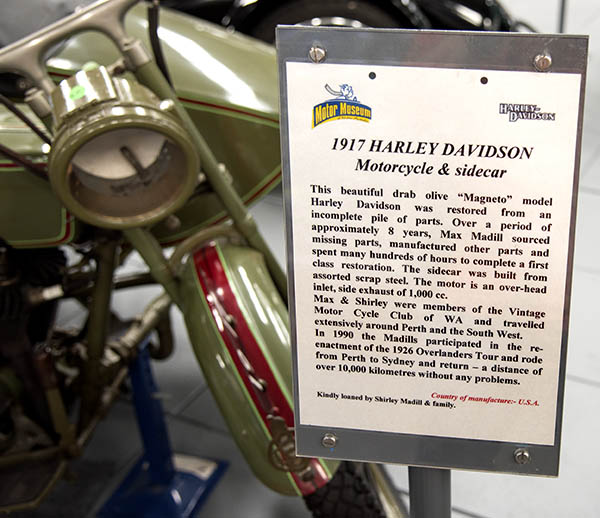
Like what you see above? Check out our other Dream Bikes, and don’t forget to sign up for our automatic email blog updates. You’ll automatically be entered in our quarterly advbook giveway!
 Most all of the fun things we did as little kids were instigated by my Grandparents. Between raising four kids and working constantly to pay for the opportunity our parents were left spent, angry and not that into family-time trips. We did try it a few times but it seems like the trips always ended with someone crying, my parents arguing or a small child missing an arm. With only 16 limbs between us we had to be careful and husband our togetherness for fear of running out.
Most all of the fun things we did as little kids were instigated by my Grandparents. Between raising four kids and working constantly to pay for the opportunity our parents were left spent, angry and not that into family-time trips. We did try it a few times but it seems like the trips always ended with someone crying, my parents arguing or a small child missing an arm. With only 16 limbs between us we had to be careful and husband our togetherness for fear of running out.
Things were very different with Gran and Gramps. We were allowed to sleep over every weekend during which we attempted to destroy their house and any of their valuable keepsakes not made from solid iron. Maybe because of our destructiveness they acted as if they liked taking us on adventures. Camping with one hundred million mosquitos at Fish Eating Creek, going to The Monkey Jungle where the people are in cages and the apes run free, and picnics at Crandon Park beach were commonplace events. We had it made.
Twice a year Gramps would take us to Daytona for the stock car races. This was back when the cars resembled production models and ran modified production engines. There was none of this Staged racing or Playoffs. We went to Daytona to see the race. It didn’t matter to us who had the most points or won the season championship because Daytona was a championship all by itself. If you asked the drivers of that era to choose between winning the Daytona 500 or winning all the other races on the schedule I bet you’d have some takers for the 500.
 We always bought infield tickets. Camping at the Daytona Speedway was included with infield tickets so we immersed ourselves in the racing and never had to leave. Gramps had a late 1960’s Ford window van with a 6-cylinder, 3-on-the-tree drivetrain. The van was fitted out inside with a bed and had a table that pivoted off the forward-most side door. To give us a better view of the racing Gramps built a roof rack out of 1” tubing. The rack had a ¾” plywood floor and was accessed via a removable ladder that hung from the rack over the right rear bumper.
We always bought infield tickets. Camping at the Daytona Speedway was included with infield tickets so we immersed ourselves in the racing and never had to leave. Gramps had a late 1960’s Ford window van with a 6-cylinder, 3-on-the-tree drivetrain. The van was fitted out inside with a bed and had a table that pivoted off the forward-most side door. To give us a better view of the racing Gramps built a roof rack out of 1” tubing. The rack had a ¾” plywood floor and was accessed via a removable ladder that hung from the rack over the right rear bumper.
At each corner and in between the corners of the roof deck were short tubes that a rope railing system fitted inside. Metal uprights slid into the short tubes and were secured by ¼-20 nuts and bolts. Rope was strung through the uprights and snugged making for a passable handrail. The railing was an attempt to keep little kids from falling off the roof of the van. Once the ladder was in place and the railing installed we would bring up chairs and a cooler. A portable AM radio provided a running commentary of the race progress. We took turns listening. It was a wonderful way to watch the races.
Back then Gramps was in what we call his silver and red period, not to be confused with his red and green period. Everything he built in that era was painted either silver or red. For some reason Gramps preferred a bargain basement silver paint that dried into a soft, chalky coating that never really hardened. The whole roof deck was painted silver except for the sockets that the uprights fitted into. Those were painted red. The stark contrast made it easy to locate the sockets.
 When you would climb the ladder to the upper deck your hands would pick up silver paint. If you sat on the deck your pants would turn silver. If you rubbed your nose like little kids do your nose would turn silver. It was like Gramps painted the deck with Never-Seez. After a full day of racing we looked like little wads of Reynolds Wrap.
When you would climb the ladder to the upper deck your hands would pick up silver paint. If you sat on the deck your pants would turn silver. If you rubbed your nose like little kids do your nose would turn silver. It was like Gramps painted the deck with Never-Seez. After a full day of racing we looked like little wads of Reynolds Wrap.
 Our camp stove was a two-burner alcohol fueled unit that, incomprehensibly, used a glass jar to contain the alcohol. Even to my 10 year-old eyes the thing looked like a ticking time bomb so I kept my distance while gramps lit matches and cussed at the stove.
Our camp stove was a two-burner alcohol fueled unit that, incomprehensibly, used a glass jar to contain the alcohol. Even to my 10 year-old eyes the thing looked like a ticking time bomb so I kept my distance while gramps lit matches and cussed at the stove.
The alcohol stove took forever to light, requiring just the perfect draft. The slightest breeze would extinguish the flame. Once lit it didn’t make much heat. Our eggs were always runny and cold. It took 3 hours to cook bacon. The plates Gramps passed out to our tiny silver hands were made from aluminum. Any residual background heat remaining from the Big Bang was quickly transferred from the food to plate ensuring everything was uniformly gross.
Gramps found great pleasure in our complaints about his food. He would smile and chuckle at us if we asked for our eggs hot. When we wished aloud for Granny to be there to make the food he really got a belly laugh. He prided himself on cooking poorly. I never understood why we had the stove in the first place. Peanut butter and jelly sandwiches would have been a lot easier and way more appetizing.
After the races were over it took forever to clear the infield. We took our time breaking down the upper deck, putting away the camping chairs and the stove and coating every surface we came in contact with a fine, silver dusting of color. I don’t know why I remember these things so clearly. It must be that silver paint, that chalky texture. I can close my eyes and feel the dry, talc-like residue on my hands even now.
A cool story, this is: An American (that would be me) goes to Western Australia to find vintage American motorcycles in a fabulous motor museum…or something along those lines.
I haven’t spotted any kangaroos yet (although eight of them did run across the front lawn of the Motor Museum of Western Australia while I was photographing this stunning 1920 Excelsior-Henderson). I missed my chance to photograph the ‘roos…but you can always get photos of kangaroos. How often do you encounter a 1920 Excelsior-Henderson?
The short story here is that Excelsior-Henderson made motorcycles from 1907 to 1931 in Chicago, they made the first motorcycle that could hit 100 mph, and they were done in by the Great Depression. Beyond that, I’ll let the photos of this magnificent motorcycle do my talking…
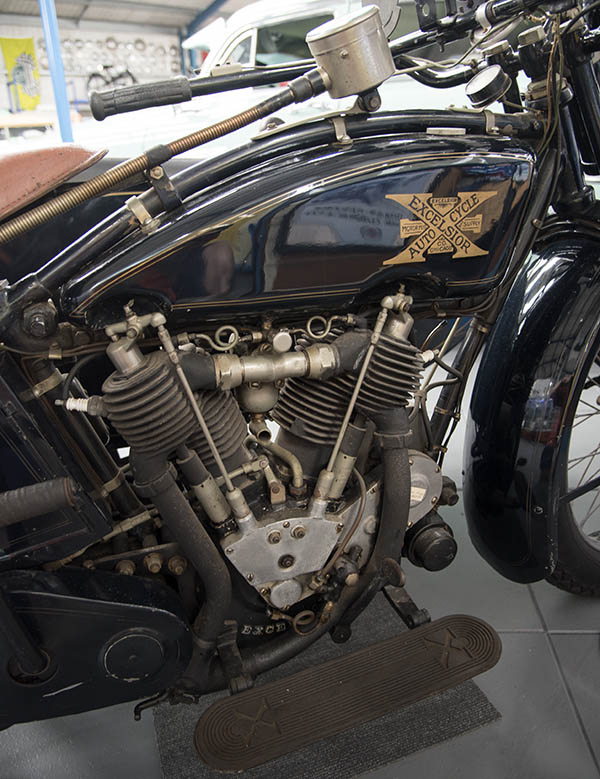
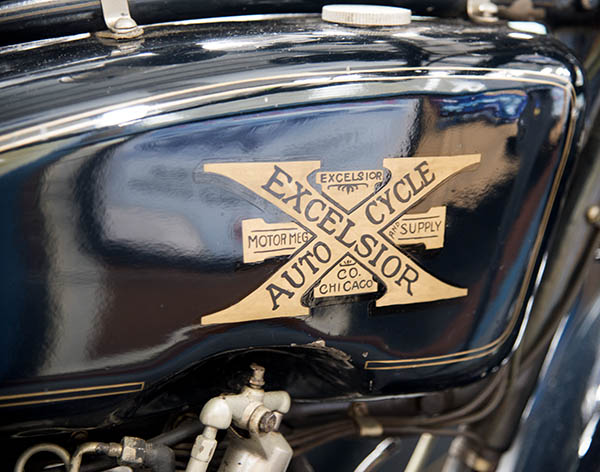
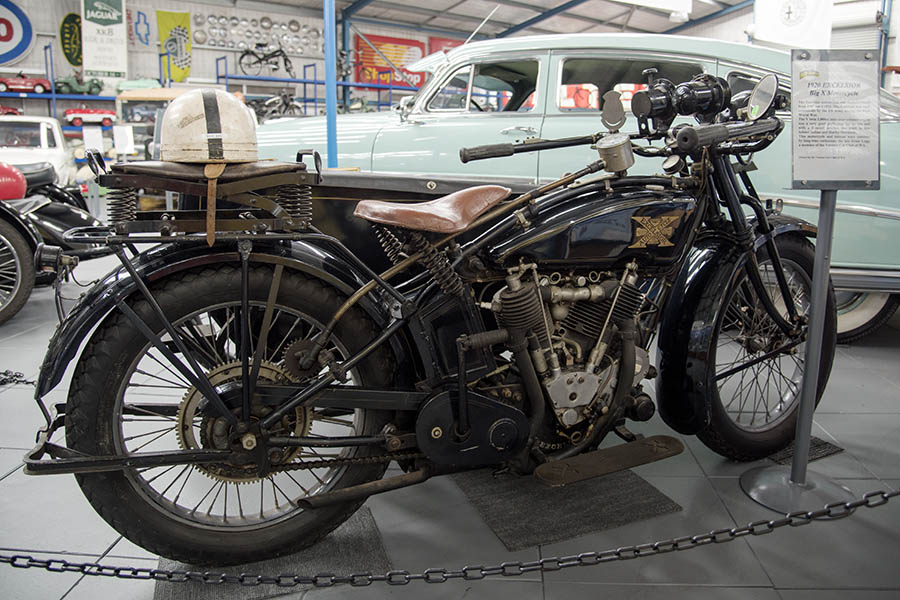
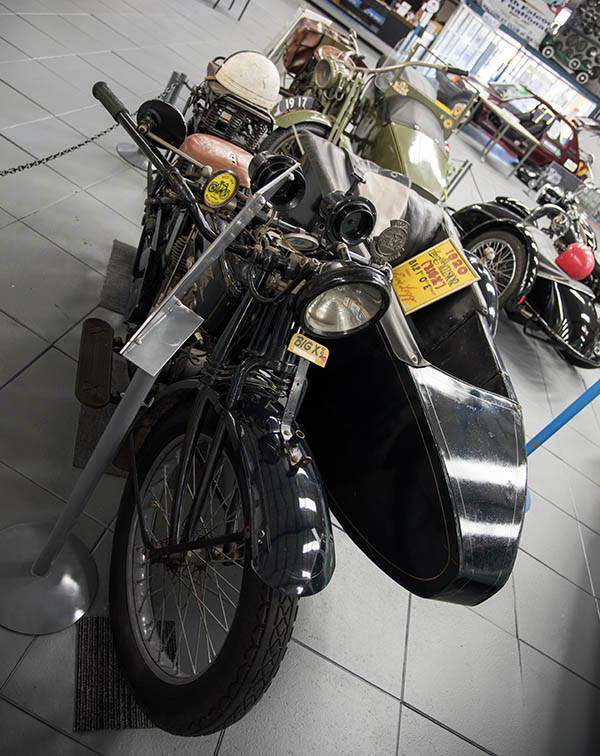
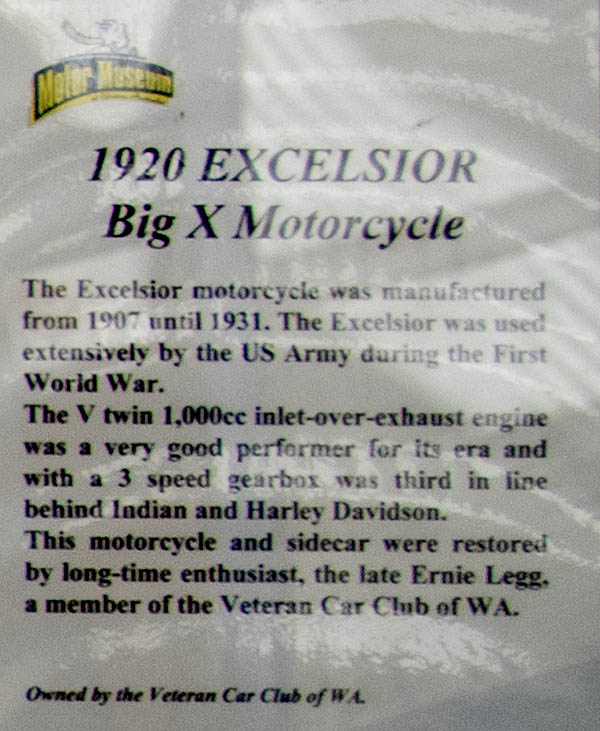 I am enjoying Australia immensely. Joe Gresh, you got it right…this is an awesome place. The western shore along the Indian Ocean, the food, the people, the scenery…it’s all amazing, and it’s not that different in feel, look, and climate than southern California. But the vintage motorcycles at the Motor Museum of Western Australia: Wowee!
I am enjoying Australia immensely. Joe Gresh, you got it right…this is an awesome place. The western shore along the Indian Ocean, the food, the people, the scenery…it’s all amazing, and it’s not that different in feel, look, and climate than southern California. But the vintage motorcycles at the Motor Museum of Western Australia: Wowee!

Everybody loves a good human interest story, and it’s hard to imagine one better than this. Sue and I are in Perth, Australia, and the specific reason we came here was for Sue to meet her lifelong pen pal Adrienne. Adrienne is from New Zealand, Sue is a California lady, and these two beautiful women have been pen pals for 56 years. Yesterday, they finally met in person for the first time. We had a great day, and I wanted to share it with you.
Good buddy Marty (with whom I’ve been riding for a long time) sent this email and photo yesterday…
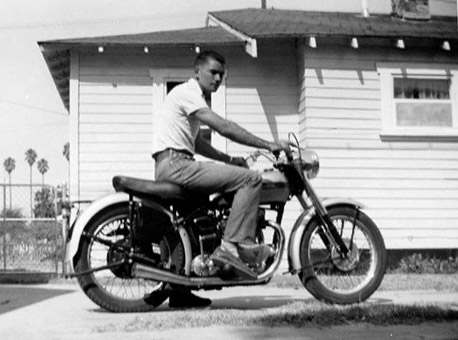 Joe,
Joe,
That is me, about 1954, on a 1953 Triumph T100C. It had a 500cc alloy engine, and (fanfare) twin carburetors (thus earning the C for competition). I loved this bike, it handled well, and for its time, was a road-burner. I ran it so hard that I collapsed a valve, and instead of fixing it, traded it on a 1957 Triumph Tiger 110 (which wasn’t as fast!). Good times, good memories.
Marty
Very cool, Marty, and thanks very much.
Marty and I have traveled a lot of miles together, including trips through the US, Baja, and the Three Flags Classic covered here on the ExNotes blog. This is a more recent photo of Marty and his BMW…
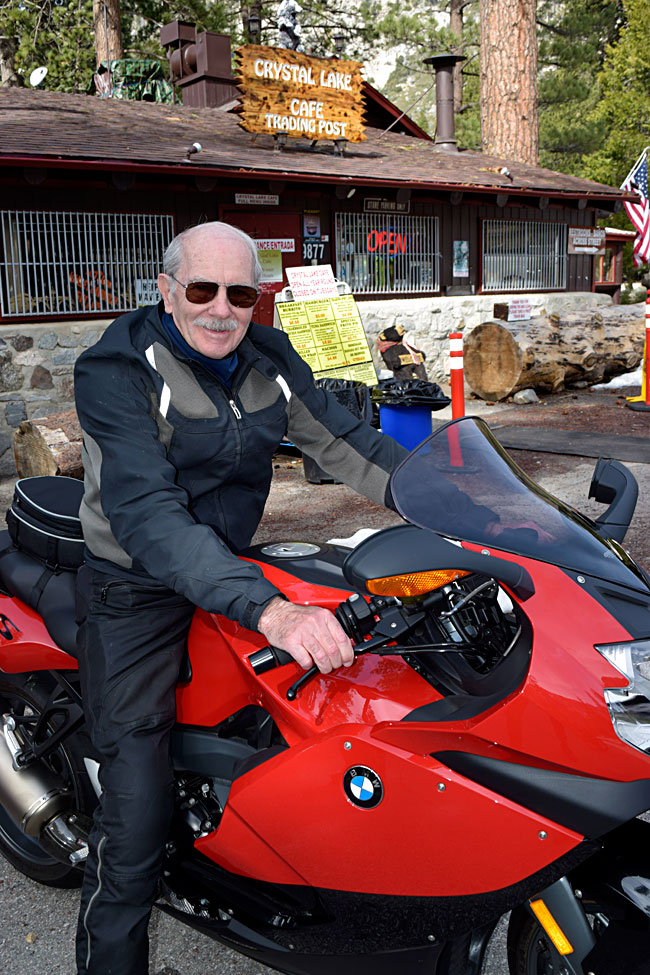
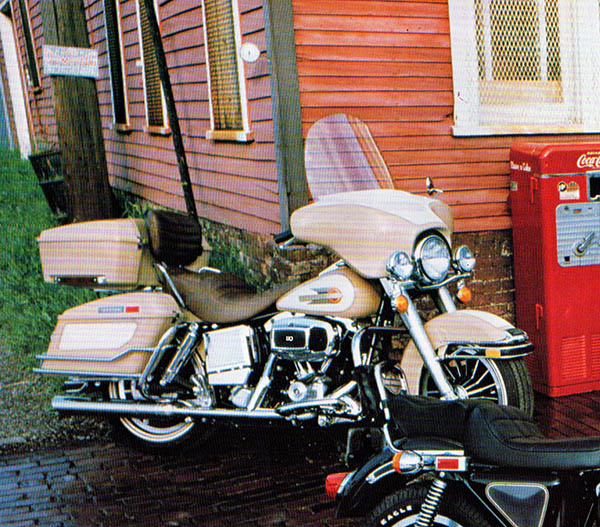
It was beautiful, it was something I always dreamed about owning, and I couldn’t ride a hundred miles on it without something breaking. I paid more for it than anything I had ever purchased, I sold it in disgust two years later for half that amount, and today it’s worth maybe five times the original purchase price. I wish I still had it. I’m talking about my 1979 Harley-Davidson Electra-Glide, of course. That’s the tan-and-cream motorcycle you see in the photo above, scanned from my original 1979 Harley brochure. The motorcycle is long gone. I had the foresight to hang on to the brochure.
All of the photos in this blog are from that brochure. I wasn’t into photography in those days, but I wish now that I had been. The Harley’s inability to go a hundred miles without a breakdown notwithstanding, I hit a lot of scenic spots in the Great State of Texas back in 1979. The Harley’s colors would have photographed well. The only photo I can remember now is one of me working on the Harley with the cylinder heads off. It seems that’s how the Harley liked to be seen. But I’m getting ahead of myself.
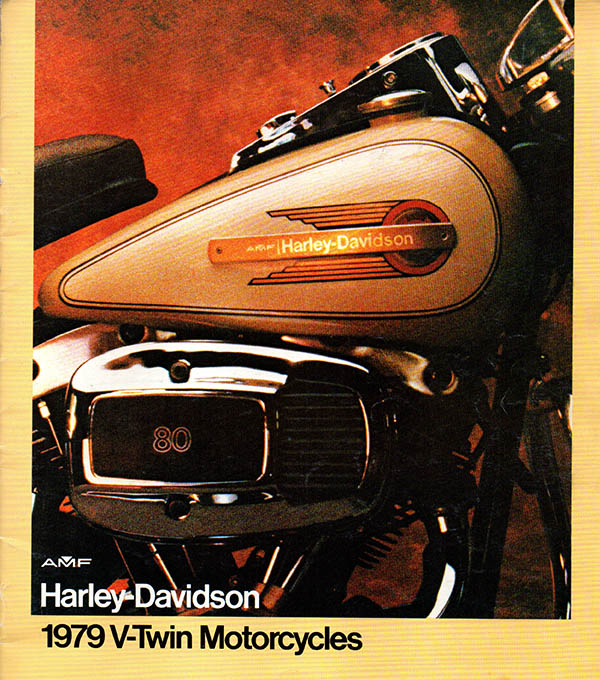
So the year was 1979, I was young and single, and I was an engineer on the F-16 at General Dynamics in Fort Worth doing the things that well-compensated, single young guys did in those days: Drinking, riding (not at the same time), chasing young women, and dreaming about motorcycles. If you had mentioned gender-neutral bathrooms, man bun hairstyles, a universal basic income, democratic socialism, sanctuary cities, the Internet, or something called email in those days (especially in Texas), no one would have had any idea what you were talking about, and if you took the time to explain such things, you would have been run out of town after being shot a few times. Texas in 1979 was a good time and a good place.
I stopped often at the Fort Worth Harley dealer, and Harley was just starting to get into the nostalgia thing. I had sold my ’78 Bonneville and I had the urge to ride again. Harley had a bike called the Café Racer and I liked it a lot, but I took a pass on that one. Then they introduced the Low Rider and I loved it, but when sitting on the showroom Low Rider I turned the handlebars and one of the handlebar risers fractured (Harleys had a few quality issues in those days). Nope, it wouldn’t be a Low Rider. Then they introduced the Electra-Glide Classic, that stunning bike you see in the photos here. It was a dagger that went straight to my heart. I was stricken.
The Electra-Glide Classic was Harley’s first big push into the nostalgia shtick and it stuck. At least for me it did. My first memory of ever being stopped dead in my tracks by a visually-arresting motorcycle was with a Harley Duo-Glide full dresser when I was a kid (it was blue and white), and the Classic brought that memory home for me. The Classic’s two-tone tan-and-cream pastels were evocative of the ‘50s, maybe a Chevy Bel Air (even though those were turquoise and white, a color Harley later adopted in the early ‘90s with its Heritage Softails). The whole thing just worked for me. I had to have it.
I sat on the Classic and it was all over for me. I fell in love. I knew at that instant that I was meant to be a Harley man. I turned the handlebars and nothing broke. There was a cool old sales guy there named Marvin, and I asked what the bike would cost out the door. He already knew the answer: $5,998.30.
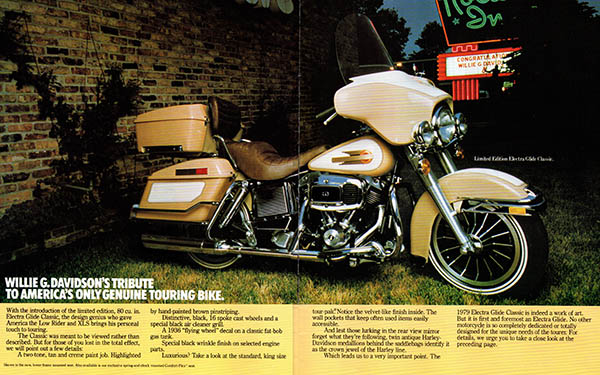
Hmmm. $5,998.30. That was a lot of money. I was riding around in a new CB-equipped Ford F-150 that had cost less than that amount (hey, it was Texas; Breaker One Nine and all that). My internal struggle (extreme want versus $5,998.30) was apparent to old Marvin.
“You know you want it,” Marvin said, smiling an oily, used-car-salesman, Brylcreem smile (these guys all went to the same clothing stores and barbers, I think). “What’s holding you back?”
“I’m trying to get my head wrapped around spending $6,000 for a motorcycle,” I said.
Marvin knew the drill. He was good at what he did. He probably made a lot more money than I did.
“Are you single?” he asked.
“Yep.”
“Working?”
“Yep.”
“Got any debt?”
“Nope.”
“So what’s your problem?”
“It’s like I said, Marvin,” I answered. “I’m trying to justify spending six grand on a motorcycle.”
“You’re single, right?”
“Yep.”
“Well, who do you need to justify it to?”
And, as Tom Hanks would say 30 years later in Forrest Gump, just like that I became a Harley rider.
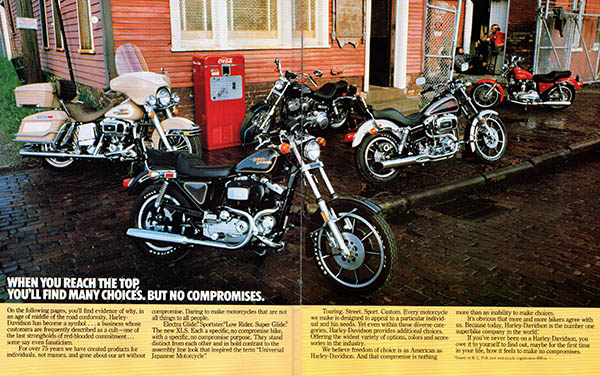
Yeah, the bike had a lot of quality issues, the most bothersome being a well-known (after you bought one, that is) tendency for the new 80-cubic-inch Shovelhead valves to stick. I first stuck a valve at around 4,000 miles (all of a sudden my Classic was a 40-cubic-inch single, and Harley fixed it on the warranty). I asked Marvin about that, and the answer was, “Yeah, this unleaded gas thing don’t work too good with the new motors. Put a little Marvel Mystery Oil in each of the tanks, or maybe a dime’s worth of diesel, and you’ll be okay…”
Seriously? Marvel Mystery Oil? Diesel fuel?
But I wanted to be good guy, and I did as directed. It wasn’t enough. A valve stuck again at 8,000 miles, Marvel Mystery Oil and that dime’s worth of diesel notwithstanding. Another trip to the dealer, and another valve job. I could see where this was going. The bike had a 12,000 mile warranty.
“So, Marvin,” I began, “what happens the next time a valve hangs up?”
Marvin smiled a knowing smile. “It all depends which side of that 12,000 miles you’re on.” Somehow, Marvin’s Texas accent made it not hurt as much.
Sure enough, at 12,473 miles, a valve stuck for a third time. This one was on me. I pulled the heads, brought them to the dealer, and paid for that valve job. You know, you can just about fix anything on a Harley with a 9/16 wrench and a screwdriver. It was easy to work on. But it wasn’t just the valves sticking. The rear disk brake had problems. The primary cover leaked incessantly. And a bunch of other little things. I’m not kidding. The mean time between failures on that bike was about a hundred miles, and I’d had enough. I called the bike my Optical Illusion. It looked like a motorcycle.
One other thing about the Harley sticks out. I took it with me when I moved to California, and at one of the dealers one of the many times when it was in for service, the dealer’s mascot did what I suddenly realized I had wanted to do. That mascot was a huge, slobbering St. Bernard. It sauntered over to my bike and took a leak on the rear wheel. “Oooh, better hose that down,” the service manager said. “That will eat up the aluminum wheel.” I had to laugh (hell, everyone else was) as the guy sprayed water from a garden hose all over the bike. That dog had beat me to it. He did what I had felt like doing the entire time I owned the bike. The kicker is that even though the service manager sprayed the bejesus out of the bike in a vain attempt to remove all traces of the St. Bernard’s territorial claims, it was all for naught. From that day on wherever I went if there was a dog within a hundred yards, it did the same thing. My Harley was a two-tone tan-and-cream traveling fire hydrant.
Good Lord, though, that Harley was beautiful. Park it anywhere and it would draw a crowd. Half the people who saw it wanted a ride, and if they were female I was happy to oblige. It was big and heavy and it didn’t handle worth a damn, but it sure was pretty. The only time I almost crashed I was riding through a strip mall parking lot admiring my reflection in the store windows. That’s how good-looking it was. I wish I kept it.
Read about our other Dream Bikes!
I enjoyed this video. I think you will, too.
Good buddy TK sent this to me a day or two ago (thanks, TK). I didn’t know the Honda Cub was the best-selling vehicle on the planet or that Honda had produced a cool 100 million of the things, and I think that number is all the more significant because several manufacturers make copies of the Cub not included in the total described in the video above. One of the other manufacturers producing a Cub variant is Zongshen. I saw several of Zongshen’s production lines during my many visits to Chongqing.
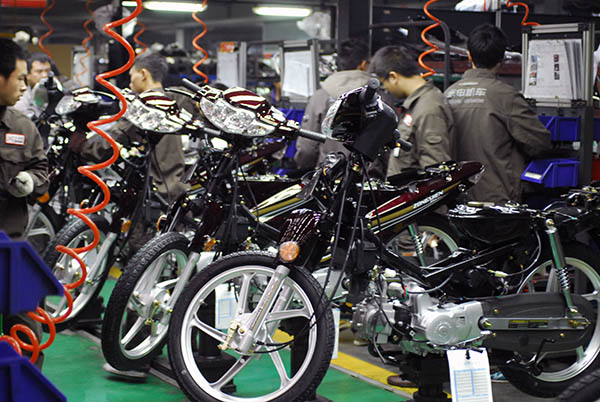

I owned a 50cc Cub back in the day. I was a teenager and a guy down the street had one he picked up in a trade of some sort. He just wanted to get rid of it and $50 later it was mine. It was fun, and it was incredibly well built. I wish I still had it.
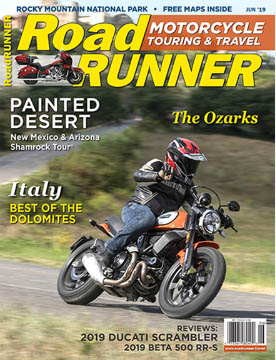 Hey, on another note, I have a new article in print this month. It’s in the June 2019 issue of RoadRUNNER magazine, and it’s on the Chinese motorcycle industry. I know a bit about that world, and yeah, I’m an unabashed fan of the Chinese. I’ve been in Chinese factories and I’ve ridden their motorcycles. The Chinese motorcycle industry’s process control and production capabilities are as good as or better than any in the world, and folks who recoil at the idea of a Chinese motorcycle are simply displaying antiquated prejudices and ignorance. I expect I’ll get a few emails and maybe a few comments on that last statement, and we welcome them. The June ’19 issue will be on the newsstands in a few more days, and for those of you who subscribe to RoadRUNNER, you are receiving your copies now. My copy arrived in the mail yesterday, and I am enjoying it enormously. The travel and other stories (and the accompanying photography) are just outstanding. If you’re not already subscribing to RoadRUNNER, you should be, and you can sign on here.
Hey, on another note, I have a new article in print this month. It’s in the June 2019 issue of RoadRUNNER magazine, and it’s on the Chinese motorcycle industry. I know a bit about that world, and yeah, I’m an unabashed fan of the Chinese. I’ve been in Chinese factories and I’ve ridden their motorcycles. The Chinese motorcycle industry’s process control and production capabilities are as good as or better than any in the world, and folks who recoil at the idea of a Chinese motorcycle are simply displaying antiquated prejudices and ignorance. I expect I’ll get a few emails and maybe a few comments on that last statement, and we welcome them. The June ’19 issue will be on the newsstands in a few more days, and for those of you who subscribe to RoadRUNNER, you are receiving your copies now. My copy arrived in the mail yesterday, and I am enjoying it enormously. The travel and other stories (and the accompanying photography) are just outstanding. If you’re not already subscribing to RoadRUNNER, you should be, and you can sign on here.
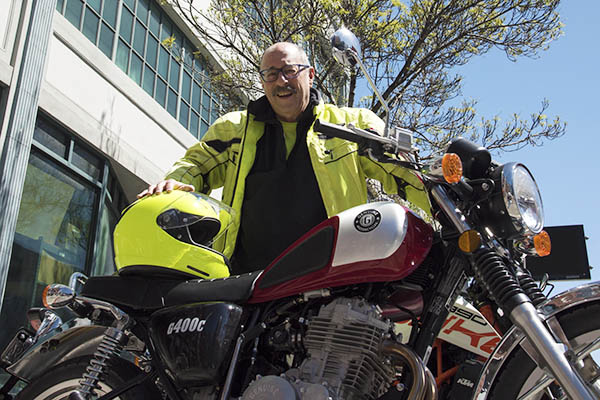
This is one of those blogs for which I could have used any of several titles. The Real Deal got the nod, as this is indeed the real deal…a genuine (pardon the pun) motorcycle. Another contender was The Streets of San Francisco, like that Karl Malden and Michael Douglas show 30 years ago. And yet another was We Are Living In Interesting Times (read on, and you’ll see what I mean).
Anyway, enough of the trip down memory lane and alternative blog titles. I made a few memories of my own yesterday, riding around downtown San Francisco around good buddy Lunchbox’s San Francisco Scooter Centre. Barry is the guy who owns and runs the dealership, but Lunchbox is the guy in charge. He’s about a year old now (I’ve known him since he was a pup), and he’s a cool 82 lbs. After checking in with Lunchbox, I visited with Barry for a bit. I always like coming up here. I like Lunchbox, I like the city, I like the San Francisco Scooter Centre, and I like Barry.

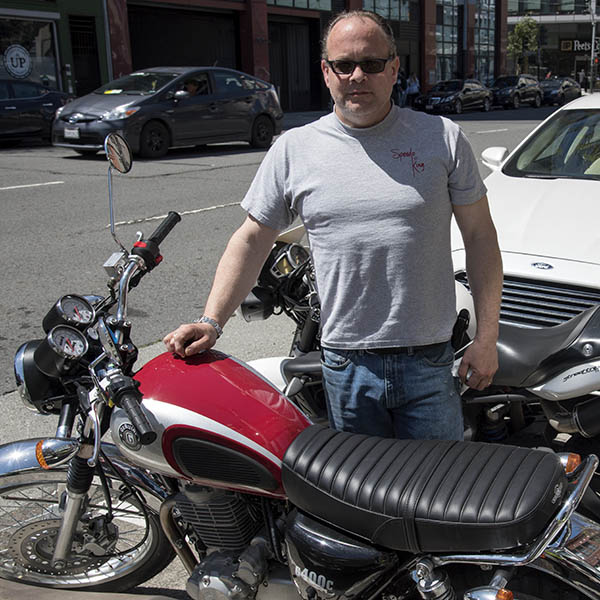
Barry and I had a great taco lunch downtown, we talked about the motorcycle market, and we swapped stories about a couple of our other common interests. Then it was time to get on the G400c. Barry tossed me the keys and the bike’s registration, and told me to have fun. Being a guy who aims to please, I did as I was told. It was easy on the Genuine.
So let me tell you about the Genuine G400c. The first thing I noticed was that it’s a motorcycle. A real motorcycle. Tear drop gas tank (where the gas actually goes), a tach and speedo that look like a tach and speedo should, and a long, low, flat seat (good for moving around on when necessary, carrying a passenger, and strapping on soft luggage for longer trips). Wire wheels. Chrome fenders. Chrome handlebars that put the controls in comfortable reach. It all came together the way it should. Yessiree, this is a motorcycle that is visually appealing. None of that Ricky Racer, low bar face on the tank, angry Ninja insect, or giraffesque ADV wannabe silliness or styling. This is a motorcycle that looks like a motorcycle should.
The next thing I noticed was that the G400c was easy to throw a leg over. It’s been a while since I’ve been on a bike where I could say that. I’ll say more on this in a bit.
And another thing I noticed was that the bike sounds like a motorcycle. A real motorcycle. A Genuine motorcycle. I like that, too. I had my big Nikon with me (the D810) and I grabbed a video of the startup sequence…
This bike sounds good. It has a nice, deep, throaty rumble. The skyscrapers I darted between in downtown San Francisco amplified the exhaust note, and the reverberations were intoxicating. There’s something undeniably cool about riding a nimble, throaty motorcycle in a city. It would have been cool to grab more video of myself riding around San Francisco, but I’m not as talented as Joe Gresh in that regard and besides, I was having too much fun. You can have a great ride or you can make a great video. Unless you’re Joe Gresh, you can’t do both at the same time.
So back to that nimble thing. You’re reading something written by a guy who thinks that somewhere in the 1970s and the 1980s the wheels came off the wagon here in the US with regard to motorcycle size and complexity, and until very recently, things have continued to get nuttier as the years have gone by and advertising guys (who are supposed to be creative people) kept defaulting to bigger has to be better. My thoughts are in synch with most of the rest of the motorcycle world (not the aforementioned advertising gurus) in that I think a 250cc is the perfect size. A 400cc single is even better, especially if it comes in a 250cc-sized package, and that’s what the G400c is.
I don’t know the Genuine’s weight. I could find it in a few seconds with a Google search, but I don’t need to. I know what I need to know from my ride, and that’s this: The G400c is light and it’s nimble, and that’s all the spec I need. Hell, you can’t trust what most of the manufacturers tell you about their bikes’ weights, anyway. And even if you could believe their numbers, what really matters is where a bike’s center of gravity is located. Make it too high, and a motorcycle will feel unwieldy regardless of its weight. Make it low, though, and a bike becomes flickable, agile, nimble, and just plain fun to ride. That’s what this machine is. I had fun splitting lanes and braaapping around downtown San Francisco. The G400c is perfect for that, but that’s not the only arena in which I see it excelling. I think the G400c would be a great bike for a Baja ride, too. Someday. We’ll see.
Next up: Seat height. It’s the same story here, folks. Like I said earlier, I could throw my leg over the seat without having to take a yoga class or do any stretching exercises, and you know what? That’s a good feeling. The saddle is low enough to make getting on and off the bike easy, and that’s decidedly not the case for a lot of motorcycles these days.
You might ask about suspension travel. When I was younger and dumber, I used to pour over the spec sheets you’d see in the motorcycle magazines, and then I realized that unless you plan to ride motocross, the only thing a ton of suspension travel does for a street bike is make thing way too tall. The G400c seat height was just where I needed it to be. And on that suspension travel topic, I’ll let you in on a little secret: Even though our taxes in California (and San Francisco in particular) are among the highest in the world, we still have lousy streets with lots of potholes and rough sections. The G400c was fine being flung around in the city, sloppy streets and road surfaces notwithstanding. It soaked it all up without a whimper. I’d like to buttonhole our politicians someday and ask them: Exactly where does all that tax money go? In the meantime, though, I know the suspension on the G400c gets the job done.
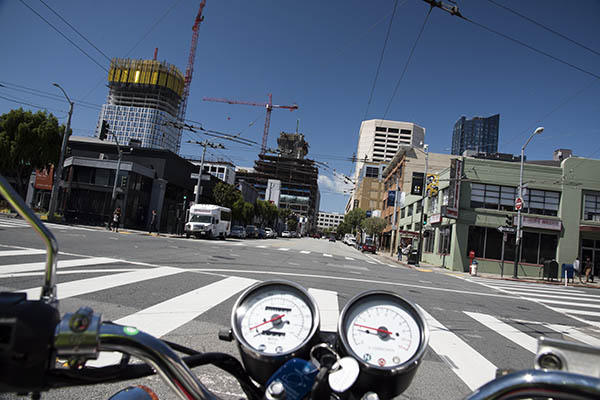
I didn’t take the G400c on the freeway, although Barry invited me to do so. Nope, the freeways are typically a mess in San Francisco, and I figured (correctly, as I experienced on the drive out of San Francisco later in the day) I could actually get more miles in and reach higher top speeds on the city streets. And I did. Until this guy you see in the photo caught up with me, lit me up, and started casting dirty looks my way. Then he got in front of me. Point taken, Officer. I rode a bit more like a normal person after that.
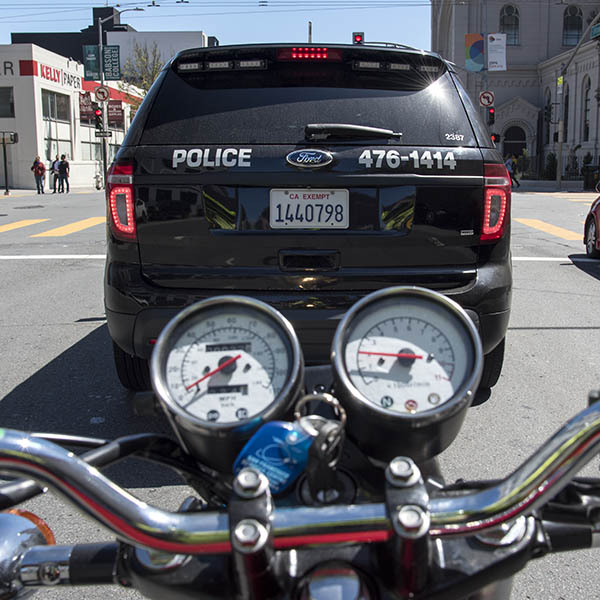
Okay, let’s not ignore the 800-lb gorilla in the room: The G400c is manufactured in China. As many of you know, I know a little bit about Chinese motorcycles and I played a tangential role in making the case for Chinese quality when CSC Motorcycles started importing the Zongshen RX3 back in 2015. You might have trepidations about buying a Chinese motorcycle, and it’s almost a certainty you know people who badmouth Chinese products. My advice when you hear the inevitable anti-China mush is to remember that God loves stupid people (because He sure made a lot of them). Yeah, they’ve got their stories about their buddy who worked at a dealer 10 years ago and he told them…well, you get the idea. Folks, these people just don’t know.

My advice is to blow these weenies off, get yourself to a dealer, and see for yourself. I know a little bit about quality and manufacturing, I’ve been in several Chinese manufacturing plants, and I’m here to tell you that Chinese motorcycle quality is as good as or better than anything that’s out there. Consider this: Automobile and motorcycle companies like BMW, Vespa, Honda, Suzuki, and many others have components, major subassemblies, engines, and complete motorcycles manufactured in China. These world-class companies wouldn’t be doing that if the quality was low.
You might have a concern about the G400c being a new bike, that is to say, one that doesn’t have a track record. Actually, that’s not the case. This motorcycle has been rolling around China for a good three years now (I saw them when I rode across China on the RX3 a few years ago). The G400c is manufactured for Genuine by Shineray (it’s pronounced Shin-yu-way), and in China, they have been selling two versions of the bike for several years (a street version and an adventure-touring-styled version). The riding in China is way tougher than it is here. We tend to use our motorcycles as toys. In China, motorcycles are work horses. They are ridden hard and put away wet.
Another thing that’s nice about the G400c motor is that it’s a Honda clone. The concept (but not the engine) here is the same as the Honda CG clone motors that power the CSC and Janus bikes…an engine based on a Honda design built for an environment where folks don’t take care of their bikes. It’s a different Honda motor design, but it’s a proven design. It’s a strong, torquey, fuel injected single.
The G400c’s braking is good. It’s a single disk in front, and a drum in the rear. A lot of folks will be grasping their chest and convulsing at the thought of a drum brake in back, but it works, and it works for me. Again, don’t let some kid writing a magazine article (or worse, someone posting an opinion on Facebook) tell you that you have to have a disk brake in back. Drum brakes have worked fine for decades. It’s one of the things keeping the cost down on this bike, and it’s a reasonable tradeoff. Like it said, it works for me.
What I don’t know yet is the parts availability question, nor do I know about the availability of a shop manual. Those are fair questions to ask a dealer. I didn’t, mostly because I was focused on the riding.
Genuine states the top speed is over 80 mph. I’ve ridden bikes with the same engine in China and I saw indicated speeds on city streets over 90 mph and the bike still had more left (and at that point I thought to myself “Whoa, Bucko…what am I doing here?”). I think the top end is more than adequate for any real world needs. And on that note, this is another area in which you hear the keyboard commandos espouse things like “Ah need a bike made in ‘Merica that can do at least a hunnert twenty miles per hour or I’ll get run over…” You do, huh? Hey, I rode across China, I’ve been up and down Baja a bunch of times, I circumnavigated the Andes Mountains in Colombia, and I’ve ridden all over the US. And I did all of this on 250cc motorcycles. Motorcycles made in China, to be specific. But what do I know?
You might ask: Are there any negatives? I guess to play magazine road test writer I have to find something, and on the G400c it might be that some of the details could be more finely finished. Maybe the handlebar switchgear castings could be polished a little more, things like that. Barry told me the bike I rode is one of the very earliest ones to arrive in America, and that Genuine is sweating the cosmetic details like this. But these are minor points. The next question would be: Would I recommend buying this bike? To that question, the answer is yes. They retail at about $4600, and with all the fees they go out the door at a notch above $5700. Barry is one of the few honest dealers I know in that he doesn’t treat setup and freight as a major profit center. Here’s how he has the bikes priced…
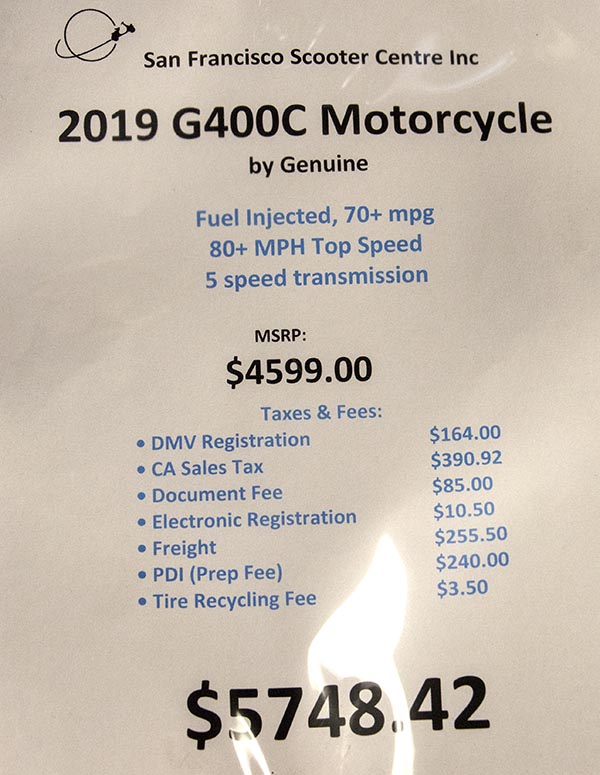
We are living in interesting times. Just a few years ago the small motorcycle landscape in the US was pretty barren, and what few bikes were out there carried stupid-high prices and obscene dealer freight and setup fees. Our choices in recent decades have been outrageously tall, fat, and heavy motorcycles with prices in the stratosphere. Today, the moto menu before us is interesting and intriguing, and it’s rooted in the real world. There’s the CSC Motorcycles line with several 250cc selections and soon, the 450cc RX4. There the Janus line of magnificently-handcrafted contemporary classics. There’s Royal Enfield, with their 400cc Himalayan, 500cc Classic, and soon-to-be-released 650cc Interceptor (at an incredible $5795). I’ve ridden nearly all of these motorcycles (I haven’t caught a ride on the Himalayan yet, but that’s coming up), and I’ve ridden many of them through Baja (you can read about our Enfield Baja trip, the Janus Baja trip, and any of several CSC Baja trips). And now, there’s another great bike in the mix: The Genuine 400c. For the first time in a long time, we have choices. Good choices that won’t break the bank. Life is good, folks.
Check out our related Genuine G400c and San Francisco Scooter Centre posts!
This is a blog I did for CSC a year or so ago, and it’s one I thought I would run again here. We haven’t done a Dream Bikes blog in a while, and it’s time.
It’s raining, it’s cold here in southern California, and those two conditions are enough to keep me indoors today. I’ve been straightening things up here in the home office, and I came across a Triumph brochure from 1978. I bought a new Bonneville that year and as I type this, I realize that was a cool 40 years ago. Wowee. Surprisingly, the brochure scanned well, so much so that even the fine print is still readable…
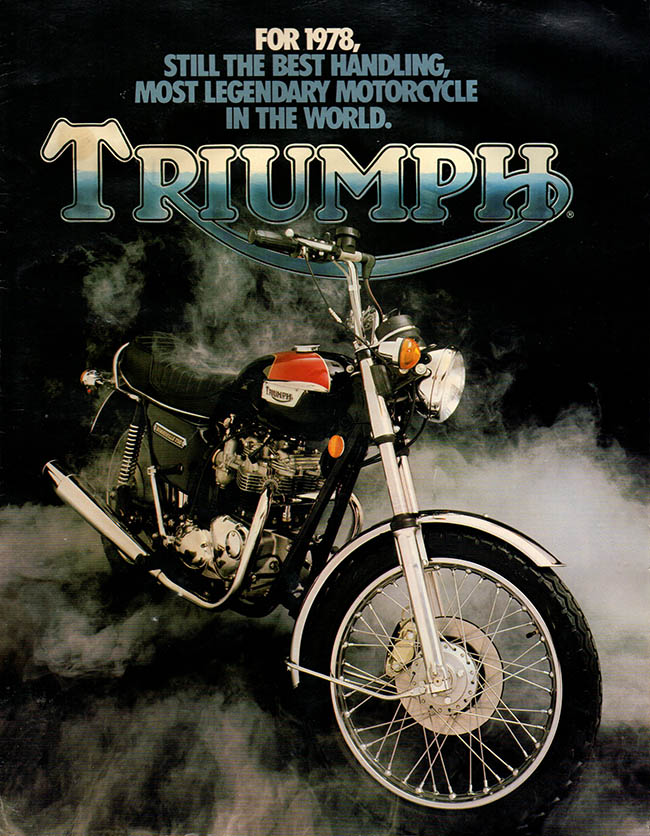
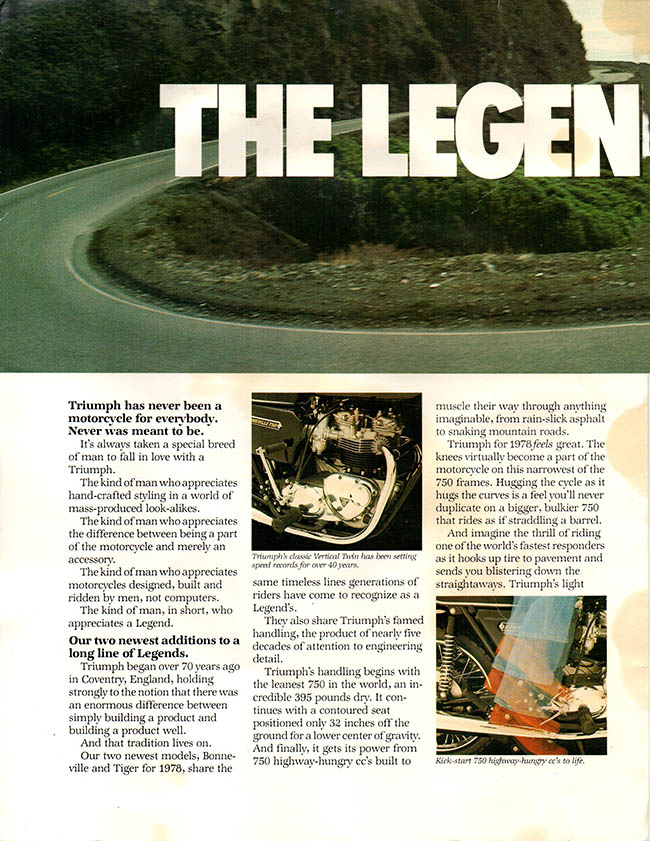
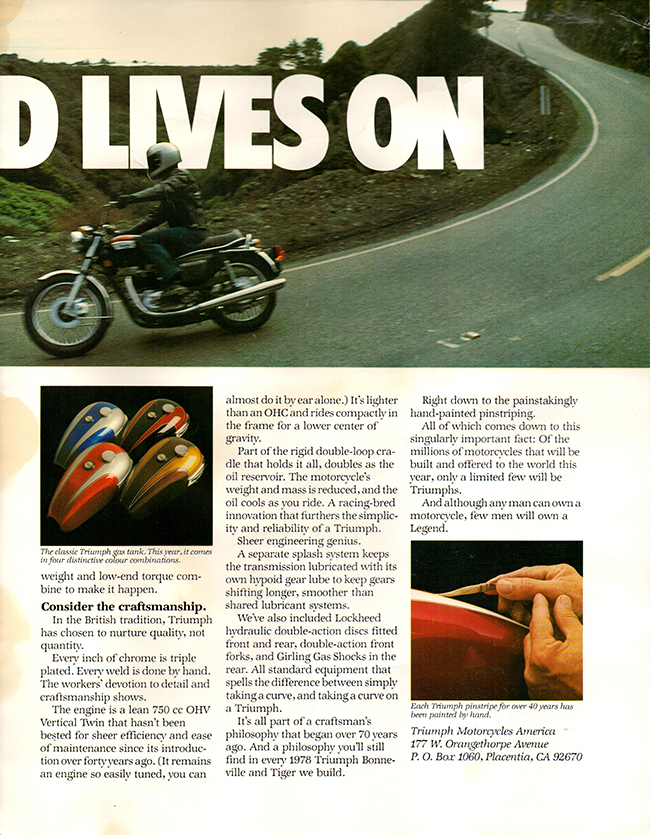
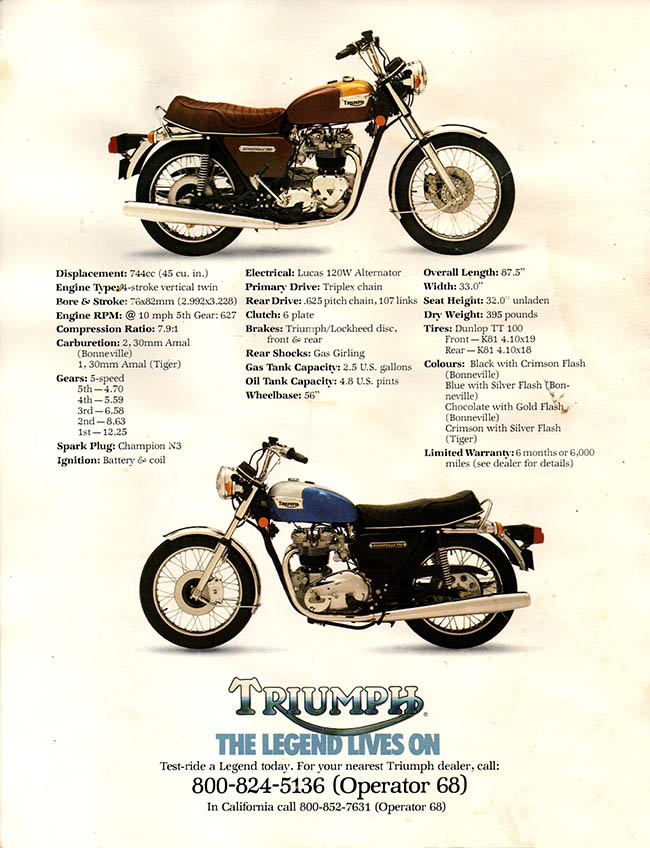
Triumph had two 750 twins back then. One was the twin-carb Bonneville, and the other was the single-carb model (I think they called it the Tiger). The Bonneville came in brown or black and the Tiger came in blue or red (you can see the color palette in the third photo above). I liked the red and my dealer (in Fort Worth) swapped the tank from a Tiger onto my Bonneville. I loved that bike, and I covered a lot of miles in Texas on it. I used to ride with a friend and fellow engineer at General Dynamics named Sam back in the F-16 days (he had a Yamaha 500cc TT model, which was another outstanding bike back in the day). I wish I still had that Bonneville.
After I sold the Bonneville, I turned right around and bought a ’79 Electra-Glide Classic. There’s a brochure buried around here somewhere on that one, and if I come across it I’ll see how it scans. The Harley had a lot of issues, but it’s another one I enjoyed owning and riding, and it’s another I wish I still owned.
So there you have it. That ’78 Bonneville is a bike I still have dreams about, and they were made all the more poignant by the Royal Enfield Interceptor I rode in Baja last month. You can read about the Enfield Interceptor and our Baja adventures here.
Want to read more pieces like this? Check out our other Dream Bikes here!